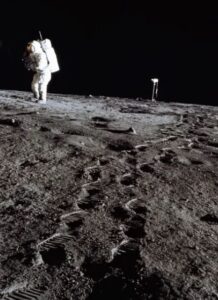
It’s not too early to start thinking about the archaeology of the Moon, contends space archaeologist Alice Gorman in an interview in The New Lean.
The Apollo 12 mission in 1969 marked the first encounter with an archaeological artifact on the Moon. Astronauts landed 180 meters away from Surveyor 3, a robotic landing craft sent to the Moon in 1967. they removed a camera and other bits and pieces to take back to Earth, When NASA analyzed the materials, they found that the Surveyor 3 and Apollo 12 landings stirred up enough lunar dust to abrade the surfaces.
Future missions are planning to visit the Apollo sites and remove samples for analysis to gauge the impact on the lunar environment on human materials. What concerns Gorman is the prospect of erasing all those original footprints and causing further damage by stirring up more dust.
There is an archaeological principle that you never excavate all of a site. You always leave an unexcavated deposit, or you leave rock art on the walls. You leave material for future scientists to sample because we don’t know what techniques will be available in the future. more “Protecting the Moon’s Archaeological Heritage”





 Foreseeable needs for space exploration exceed projected payroll-launch capacity, so NASA envisions the need for robotic manufacturing on the Moon. A newly funded project called The Assemblers envisions a swarm of robots fabricating solar arrays and undertaking other assembly tasks on the surface of the Moon or Mars.
Foreseeable needs for space exploration exceed projected payroll-launch capacity, so NASA envisions the need for robotic manufacturing on the Moon. A newly funded project called The Assemblers envisions a swarm of robots fabricating solar arrays and undertaking other assembly tasks on the surface of the Moon or Mars.
 Once upon a time the Moon had a magnetic field, and it was likely stronger than Earth’s is today. That field, generated by a powerful dynamo in the Moon’s core, petered out about one billion years ago.
Once upon a time the Moon had a magnetic field, and it was likely stronger than Earth’s is today. That field, generated by a powerful dynamo in the Moon’s core, petered out about one billion years ago.